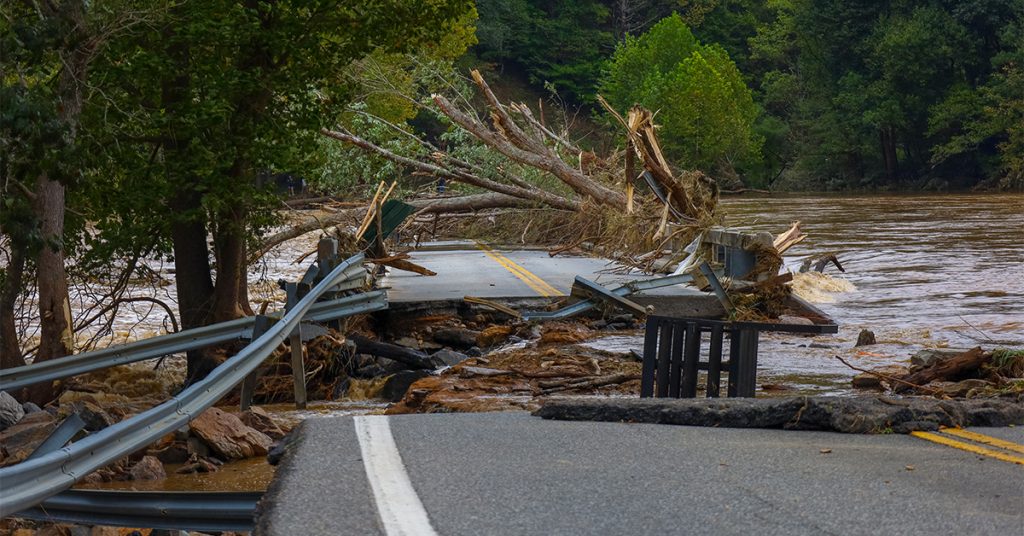Hurricanes aren’t just a southern concern anymore. While Florida and the Gulf Coast often make headlines for boarding up homes and mass evacuations, New Englanders have learned the hard way that we’re not out of reach. From Superstorm Sandy in 2012 to Tropical Storm Henri in 2021, our region has faced flooded roads, widespread power outages, and millions in property damage.
Just last year, torrential rains from a tropical system devastated towns across Vermont — from Ludlow in the south all the way up to the Northeast Kingdom — leaving families displaced and businesses underwater. In fact, Vermont has seen flooding on the very same July day three years in a row, a stark reminder of how climate patterns are changing in our own backyard.
The Atlantic hurricane season runs from June 1 to November 30 — the prime window when storms form in the North Atlantic – and typically peaks between mid-August and mid-September. For New England homeowners, that means the season is in full swing, and the risks are real.
Climate data shows that storms are becoming more frequent, more destructive, and more costly. In 2024 alone, the U.S. experienced twenty-seven separate billion-dollar disasters, totaling $182.7 billion in damage. New England, with its dense coastal communities, historic homes, and aging infrastructure, is particularly vulnerable.
The urgency is clear: ensuring your home and your loved ones are safe during hurricane season is a must. Let’s dive into how insurance can help protect you.
Topics Covered
The Hidden Gaps in Your Homeowners Policy
Many homeowners think, “I have insurance, I’m covered.” But when it comes to hurricanes, the fine print matters. Let’s break down the biggest blind spots:
1. Hurricane & Windstorm Deductibles
For New Hampshire and Vermont homeowners, practices vary. Some insurers may apply “named storm” or “windstorm” deductible endorsements, while others handle wind damage under your standard deductible. The key takeaway is to review your policy’s deductible section carefully, especially under “Windstorm,” “Named Storm,” or “Hurricane” clauses, and confirm with your agent how your coverage would respond in the event of a storm.
By contrast, in coastal New England states like Massachusetts, Rhode Island, and Connecticut, many homeowners’ policies include a separate hurricane or windstorm deductible. Unlike a flat $1,000 or $2,500 deductible, these are often percentage-based – usually between 1% and 5% of your home’s insured value. For example, if your home is insured for $400,000 and your policy carries a 5% hurricane deductible, you’d need to pay $20,000 out of pocket before coverage applies. These deductibles are typically triggered when the National Weather Service declares a hurricane or named storm affecting your area.
Pro Tip: Don’t assume your deductible is the same across all events. Review your declarations page or call your agent to confirm how a hurricane deductible applies.
Do not assume your insurance company knows you have a dog. When you apply for a policy or add a pet to your household, you must inform your insurer. If you fail to disclose the presence of your pet—especially one considered higher risk—and your dog injures someone, the insurer may deny the claim. Be honest about your pet’s breed, age, and bite history so that coverage is clear before something happens.

2. Wind vs. Water Damage
Hurricanes bring high winds as well as water, and how that water enters your home makes a difference in terms of coverage.
- Wind damage: Usually covered. This includes shingles ripped off by high winds, windows shattered by debris, or siding torn loose.
- Wind-driven rain: Covered if the storm damages your roof or windows, allowing water inside.
- Flooding and storm surge: Not covered under standard homeowners insurance. For that, you need separate flood insurance through FEMA’s National Flood Insurance Program (NFIP) or a private insurer.
Pro Tip: Even if you don’t live on the coast, inland flooding from heavy rain or overflowing rivers is a growing risk in New England. FEMA reports that 20% of flood claims come from outside of high-risk zones.
3. Additional Living Expenses (ALE)
What if your home is uninhabitable after a hurricane? Most policies include ALE coverage, which pays for hotels, rentals, or meals while your home is being repaired. But not all policies are equal.Pro Tip: Check your ALE limits and timeframes. Will it cover 6 months of temporary housing? 12 months? Knowing this now avoids headaches later.
How to Protect Your Home Before the Next Storm
The good news is that homeowners have more control than they think. By taking a proactive approach, you can close coverage gaps, reduce risk, and avoid financial surprises.
Coverage Checklist: Review Your Policy
- Ask about hurricane/windstorm deductibles: Is yours 1%, 3%, or 5%? What would that mean in dollars? Can you cover your deductible out-of-pocket in the event of a claim?
- Confirm flood coverage: Standard policies don’t cover storm surge. NFIP flood policies take 30 days to go into effect, so don’t wait until a storm is on the radar.
- Check ALE limits: Ensure they’re realistic for your area’s housing market and your unique needs.
- Understand exclusions: Mold, earth movement, or sewer backups may require endorsements.
Property Checklist: Prep Your Home
- Roof inspection: Fix loose shingles or flashing.
- Trim trees: Branches near your roof could become flying hazards.
- Secure outdoor items: Grills, patio furniture, and planters can become projectiles. Store them away in a safe location or fasten them down.
- Clear gutters and drains: Prevent water from pooling around your foundation and leaking into your home.
- Backup power: Consider a generator to keep essential systems like sump pumps and refrigerators running.
Financial Checklist: Plan for Out-of-Pocket Costs
- Calculate your hurricane deductible in dollars. Set aside emergency savings to cover it.
- Keep digital copies of your insurance documents and inventory photos/videos.
- Review with your agent annually: Coverage needs change as home values and risks evolve.
Pro Tip: Bundle home improvements with insurance reviews. For example, if you’re installing a new roof, ask your agent about potential discounts or credits for wind-resistant materials.
Steps to Take Before the Wind Starts Howling
You don’t want to be standing in the dark after a storm, realizing your insurance won’t cover half the damage. The time to discover a coverage gap is not after the roof caves in or water fills your basement. A 30-minute policy review could save you tens of thousands of dollars. Here’s what you can do right now:
- Call your insurance agent this week. Ask three questions: Do I have a hurricane deductible? How much flood coverage do I have? What are my ALE limits?
- Consider a flood policy. With storms intensifying, even inland New England communities are seeing unexpected flooding.
- Prep your property. Take small, inexpensive steps today that could prevent thousands in damage tomorrow.
- Stay aware of the weather. Sign up for local alerts from the National Weather Service or other local weather alert services.
FAQ: Hurricane Coverage Questions
Does renters insurance cover hurricane damage?
Yes, but only for personal belongings. The building itself is covered by the landlord’s policy. Flood damage still requires separate coverage.
Can I lower my hurricane deductible?
Sometimes. Insurers may offer options to lower the percentage in exchange for a higher premium. Ask your agent to run the numbers.
Do I need flood insurance if I don’t live on the coast?
Possibly. FEMA notes 20% of claims are outside high-risk zones. Rivers, marshes, and even low-lying roads can flood.
What about condominiums?
Your condominium association’s master policy likely covers exterior damage. Your personal policy (HO-6) covers the inside of your unit. Check both for deductibles.
Will insurance pay for hotels if my home is uninhabitable?
Yes, under ALE coverage. Just confirm your policy’s limits and keep receipts.
How do I know if I have a hurricane deductible?
Look on your declarations page under “windstorm,” “named storm,” or “hurricane deductible.” Or simply call your agent.
Stay Ahead of the Season
Hurricanes in New England have become an evolving risk that demands preparation By understanding your policy, adding flood insurance where needed, and taking small preventive actions, you can dramatically reduce your financial exposure.
As premiums rise, projected to increase 8% in 2025, with average annual costs hitting $3,520 nationally, every dollar counts. The right preparation now ensures you’re not paying thousands later out of pocket.
Bottom line: Review your coverage today, prep your property, and stay weather aware. When the next storm rolls through New England, you’ll have the peace of mind that comes from knowing you’re ready.
Need to learn more about homeowners insurance?
Our agents are ready to help, so contact us to learn how we can customize your insurance policies to meet your needs.
*Disclaimer: We offer content for informational purposes; Co-operative Insurance Companies may not provide all the services or products listed here. Please get in touch with your local agent to learn how we can help with your insurance needs.
Sources
American Red Cross. Hurricane Safety. https://www.redcross.org/get-help/how-to-prepare-for-emergencies/types-of-emergencies/hurricane.html
CBS News. Most U.S. Homeowners Hit by Hurricane Helene Don’t Have Flood Insurance. https://www.cbsnews.com/news/insurance-hurricane-helene-florida-north-carolina-fema-flood-homeowners/
DF Murphy Insurance. Get Ready for Hurricane Season in New England: What You Need to Know. https://www.dfmurphy.com/blog/get-ready-for-hurricane-season-in-new-england-what-you-need-to-know
FEMA. National Flood Insurance Program (NFIP). https://www.fema.gov/flood-insurance
FEMA NFIP. Fast Facts on Floods & Flood Insurance (November 2024 Infographic). https://agents.floodsmart.gov/sites/default/files/media/document/2025-07/fema-nfip-fast-facts-flood-insurance-infographic-11-2024.pdf
Insurify. Insurify Projects 2025 Home Insurance Costs Will Increase up to 27% in Some States. https://www.prnewswire.com/news-releases/insurify-projects-2025-home-insurance-costs-will-increase-up-to-27-in-some-states-302422521.html
National Association of Insurance Commissioners (NAIC). Flood Insurance Consumer Information. https://content.naic.org/consumer/flood-insurance
NOAA. NOAA Predicts Above-Normal 2024 Atlantic Hurricane Season. https://www.noaa.gov/news-release/noaa-predicts-above-normal-2024-atlantic-hurricane-season
NOAA. U.S. 2024 Billion-Dollar Weather and Climate Disasters Report. https://www.ncei.noaa.gov/access/billions/
Ready.gov. Hurricanes. https://www.ready.gov/hurricanes
VTdigger.com. Vermont has seen flooding on the same day for the past 3 years. For residents, the latest storm was ‘a slap in the face.’ https://vtdigger.org/2025/07/11/vermont-has-seen-flooding-on-the-same-day-for-the-past-3-years-for-residents-the-latest-storm-was-a-slap-in-the-face/

